

Research Conference Handout.pptx. Decoupling summative and formative assessment. The following post is my seminar notes from a session I ran with Christine Counsell on why ‘summative’ and ‘formative’ assessment need to be decoupled, particularly in terms of not principally using summative marking criteria to inform teaching.

I am particularly grateful to the history teaching community (particularly the so-called ‘History Pizza Assessment Group’ in Cambridge) and Daisy Christodoulou for helping me clear up my thinking on this matter. The current prevailing model in formative assessment is to give pupils a task (an essay, an exam question, a piece of music to play) and then to judge their competence at that task using a series of levels, often based on either task-specific or generic descriptions of competence. Having ascertained how well a pupil performed on that task, we then identify what was absent from the performance: what should have been done that was not, or what could have been done better? And, in some ways, this is fine. But herein lies the problem. Practice Shared by Colleagues @sheffcol 16/17. Getting Better at Feedback.
The last few weeks have seen us progress through each of our Cornerstones of Teaching & Learning at The Sheffield College with drop-ins from the Digital and e-Learning team, links to browse via our Twitter feed and a blog each week for staff to reflect on – So in the fourth and final week, our attention turns to feedback.
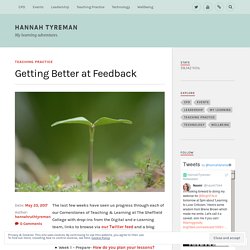
As I spent some time reviewing and gathering links related to feedback, I realised that if I let it, it could easily fill my entire week. BTEC internal assessment. When can I give my learners feedback and encouragement? What feedback can I give during the assessment? READING - A marked improvement? A review of the evidence on written marking. Dr Dylan Wiliam The Secret of Effective Feedback. VIDEO - John Hattie and Helen Timperley on Feedback. READING - Dylan Wiliam - The Secret to Effective Feedback. READING- Feedback Interventions- Towards the Understanding of a Double-Edged Sword. 5 key strategies for effective formative assessment. The Education Endowment Foundation.
Shute- Focus on Formative Feedback. 5 Research-Based Tips for Providing Students with Meaningful Feedback. In recent years, research has confirmed what most teachers already knew: Providing students with meaningful feedback can greatly enhance their learning and achievement.

Professor James Pennebaker from the University of Texas at Austin has been researching the benefits of frequent testing and the feedback it leads to. He explains that in the history of the study of learning, the role of feedback has always been central: “When people are trying to learn new skills, they must get some information that tells them whether or not they are doing the right thing.
Learning in the classroom is no exception. Both the mastery of content and, more importantly, the mastery of how to think require trial-and-error learning.” The downside, of course, is that not all feedback is equally effective, and it can even be counterproductive, especially if it’s presented in a solely negative or corrective way. So what exactly are the most effective ways to use feedback in educational settings?
1. 2. 3. 4. 5. READING - The Power of Feedback- John Hattie. READING- Guidance for managers writing marking policies. RESOURCE- Reduce Workload. READING- Less is More – Marking with a Purpose. This weekend I had the pleasure of presenting at #PedagooHampshire16.
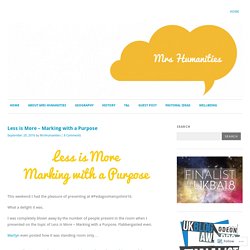
What a delight it was. I was completely blown away by the number of people present in the room when I presented on the topic of Less is More – Marking with a Purpose. Flabbergasted even. Martyn even posted how it was standing room only… Standing room only @MrsHumanities #pedagoohampshire16 making feedback more effective pic.twitter.com/demQrSFCZ0— Martyn Reah (@MartynReah) 17 September 2016 For someone as introverted as I, this was a majorly proud moment. The first time I spoke was at TMHistoryIcons, I loved it but nerves got the better of me that time. READING- Fast Feedback. Our first Magic Monday kicked off at lunchtime with a “Pedagogy Picnic”.
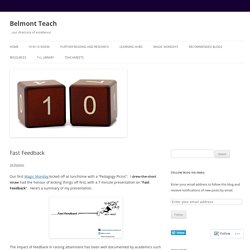
I drew the short straw had the honour of kicking things off first, with a 7 minute presentation on “Fast Feedback“. Here’s a summary of my presentation. The impact of feedback in raising attainment has been well documented by academics such as Dylan Wiliam, John Hattie and more recently by the Sutton Trust Education Endowment Foundation in their Toolkit findings. Written feedback can be a time consuming task though and the purpose of this presentation was to try to pull together a variety of methods that could speed up feedback, without compromising the quality of it.
I wanted to share a range of strategies, rather than focus in more detail on a few. Tech Ideas for Feedback - Slides. VIDEO- Precise Praise- Doug Lemov. READING- Feedback – Beyond Marking. One of the many lovely things about being involved in the Pedagogy Innovation team at our school is that it gives you not only permission but also an obligation to pry in to other people’s classrooms.
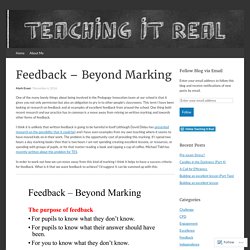
This term I have been looking at research on feedback and at examples of excellent feedback from around the school. One thing both recent research and our practice has in common is a move away from relying on written marking and towards other forms of feedback. I think it is unlikely that written feedback is going to be harmful in itself (although David Didau has presented research on the possibility that it could be) and I have seen examples from my own teaching where it seems to have moved kids on in their work.
The problem is the opportunity cost of providing this marking. GrowthMindsetFeedbackTool. Whole Class Feedback & Crib Sheet Handout – mrthorntonteach. VIDEO - Critique & Perfection. Our T&L Quick Wins: Book work @Team_English1 Helping students understand why it matters. READING- Oral Formative Feedback – Top 10 Strategies. Quite simply, effective teaching hinges on oral formative feedback and questioning on a lesson by lesson basis.
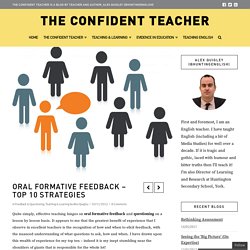
It appears to me that the greatest benefit of experience that I observe in excellent teachers is the recognition of how and when to elicit feedback, with the nuanced understanding of what questions to ask, how and when. I have drawn upon this wealth of experience for my top ten – indeed it is my inept stumbling near the shoulders of giants that is responsible for the whole lot! In nearly all of these examples the feedback includes all three parties possible in the class: the learner, peers and the teacher. I dispute the idea of peer feedback as an undertaking exclusive of the teacher – we are always there steering the feedback, establishing ground rules and success criteria, modifying and adjusting the feedback of peers – that is why we are the paid experts!
READING- WWW, EBI & INT. This month's blogsync topic is all about marking and all entries can be seen by going to There are already some fantastic entries, none of which I will try to emulate here, but I will give my account of the marking expectations at my school and how I have gone about this task over the past half term.

Follow the #blogsync conversations on Twitter using #blogsync. RESOURCE- Maths Plasters. Not my idea, but an absolute blinder courtesy of @ListerKev (Kev’s blog) and @ASTsupportAAli who originally posted about using these for literacy here Agility – The teaching toolkit.

Its working so well, I wanted to share as part of the October #blogsync 8: “Marking with Impact” … don’t get me wrong its not a panacea, but is saving me time and the novelty value means that the students are reading the comments. Every half term, we complete a marking cycle of assessments with books marked and in conjunction with the test feedback, targets are set both by the students and the teacher. As part of the cycle, weekly homework is set and marked, a peer assessment of books takes place and we also complete a book monitoring check. Whilst doing this, I still like to write comments, but find myself repeating the same thing, so having stickers that I can just pop on the page is brilliant and saving me so much time. So far the comments I’ve done are: READING- Marking. Encouraging and evidencing dialogue. In order to make judgements of quality of teaching and progress over time, Ofsted inspectors are looking for high quality feedback which crucially is acted on by the student.
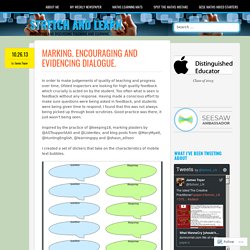
Too often what is seen is feedback without any response. Having made a conscious effort to make sure questions were being asked in feedback, and students were being given time to respond, I found that this was not always being picked up through book scrutinies. Good practice was there, it just wasn’t being seen. READING - Feedback: In Search of The Holy Grail. Over the last 6 years I have, sadly, not discovered the holy grail of feedback. Call me a cynic but I don’t think it actually exists. This post exists merely as an account of my journey in search for it so far.
READING- Fabulous Feedback. There are a number of areas of my teaching practice that I’m looking to seriously improve this year and I’ve been writing about each aspect over the last few weeks. Perhaps of the utmost importance is feedback and marking. READING- ‘Gallery Critique’ in the Classroom. “I believe that work of excellence is transformational. Once a student sees that he or she is capable of excellence, that student is never quite the same.
There is a new self-image, a new notion of possibility. There is an appetite for excellence. After students have had a taste of excellence, they’re never quite satisfied with less; they’re always hungry.” (page 8, ‘An Ethic of Excellence’ by Ron Berger) READING - Giving feedback the ‘Michaela’ way. I’ve written before about marking, but just to summarise: it has always been something I’ve loved doing. There was something in that Boxer-like satisfaction of ploughing through an unending pile of books, leaving lovingly crafted comments in an array of coloured pens and stickers that just looked like it would work so well. How could pupils fail to make progress when I’d spent so many hours on them? So something I was nervous about when starting at Michaela was their approach to marking; that is, don’t do it. I’d read Joe Kirby’s blog and spoken to him at length, but remained steadfastly concerned that marking worked – if you ensured pupils acted on feedback.
READING- Marking Crib Sheet. Recently, I have been looking at our departments marking procedures and how best to be effective markers (obviously reducing workload is key!). I designed this crib sheet as a way to provide quicker feedback to the whole classroom rather than writing comments in each book, so reducing marking time from 2-3 hours per class to less than an hour. Now I actually really do miss writing comments, leaving questions and the other bits in their books but it really wasn’t a workload issue I could continue with (especially as I have my first child on the way!). Therefore the crib sheet allows me to go through each students’ book and I make comments on the whole class sheet using the sections below.
The benefits are that it gives me a snapshot of the whole class’s progress, allows me to ‘fine tune’ my lesson planning and it also gives activities and tasks for students to complete within DIRT the next lesson. Pupils books look something like this – we do this every 2 weeks or so. READING- Improving Written Feedback. This week I gave a seminar at TeachMeet Clevedon. READING- How to Grade Writing Assignments. As the spring semester wraps up, the grading tends to pile up. As college professors, we’ve noticed that we spend a lot of time grading papers, and we worry about whether the time we put into providing feedback really helps our students learn. READING- Making Feedback Count: “Close the Gap” READING - Marking for Feedback. Having assumed my current role as Head of Maths, it has been a busy first term, with a fair amount of change being introduced. READING- Whole-class marking: KS4 mock exam. Using mobile devices to give video feedback.
#techtuesday Cornerstones - Feedback. RESOURCE - Student reflection sheet. VIDEO - Metacognition. VIDEO - How Thinking Works. RESOURCE - Thinking Dice. READING- Metacognition. Post written by: NKA This post summarises ideas that were tried by teachers from the Science department following our initial Journal Club meeting. We had read about how effective metacognition and self-regulation can be in helping students to progress. We wanted to encourage them to self-assess their work, taking time to think through what they’d done and why. We also wanted them to think about what they might do differently next time. READING- More Metacognition. This post is written by VBA. Metacognition and “thinking about thinking” became a real focus of mine with my Year 10 GCSE class after reading about the low cost – high impact that it can have on a student’s performance in this report from the Educational Endowment Foundation.
I followed this up by reading blog articles about teachers who had put metacognition into practice. The ones I found most informative were: Metacognition and academic growth, Developing metacognition through exam practice and …what really works when preparing students for their examinations. RESOURCE - 35 Questions for Student Reflection. RESOURCE - The Plenary Producer. RESOURCE - Learning Journal. READING - 10 ways to encourage student reflection. Split Screen Teaching Optimal learning occurs when students are active participants in their own learning, rather than passive recipients of teacher-delivered content. READING - Level Up Metacognition. RESOURCE- 'KWL' chart. READING- The feedback continuum: why reducing feedback helps students learn. ‘Making Every Lesson Count’ informed feedback experiments. READING- Understanding why feedback doesn't stick. VIDEO- Give the Feedback Before the Race is Run.
READING- Making Marking Meaningful. VIDEO - Dylan Wiliam on Feedback. READING- Making feedback stick. Feedback most common… – tips4teaching. Tackling over-reliance on marking. Folding feedback into learning – James Durran. READING- Marking in Perspective: Selective, Formative, Effective, Reflective. READING- Video and Verbal Feedback. READING - Why Feedback Should Come in the Middle, Not at the End. READING- Dedicated Improvement and Reflection Time.
READING- Marking is an act of love. READING- Less marking, more feedback: A challenge and a proposal. READING- Verbal feedback: Telling them what to do. READING- Have We Got Feedback Backwards? READING- Feedback on feedback (and marking) We Still Don't Know What Works. READING- What should written feedback look like? VIDEO - Marking and Feedback. READING- Is Your Feedback Carefully Used, or Barely Perused? READING- Feedback using comparative judgement. READING- ‘Post-mortem Marking’ vs ‘Live Marking’ READING- Critique – it’s a culture thing. READING- Public Critique. READING- More effective written feedback. Making Good Progress? Bloomsbury CPD Library- Marking & Feedback. The Feedback Fix: Dump the Past, Embrace the Future, and Lead the Way to Change. Feedback Pocketbook.
Thanks for the Feedback: The Science and Art of Receiving Feedback Well. Feedback: The Communication of Praise, Criticism, and Advice. Embedded Formative Assessment. Visible Learning for Teachers. Inside the Black Box. Mindset.